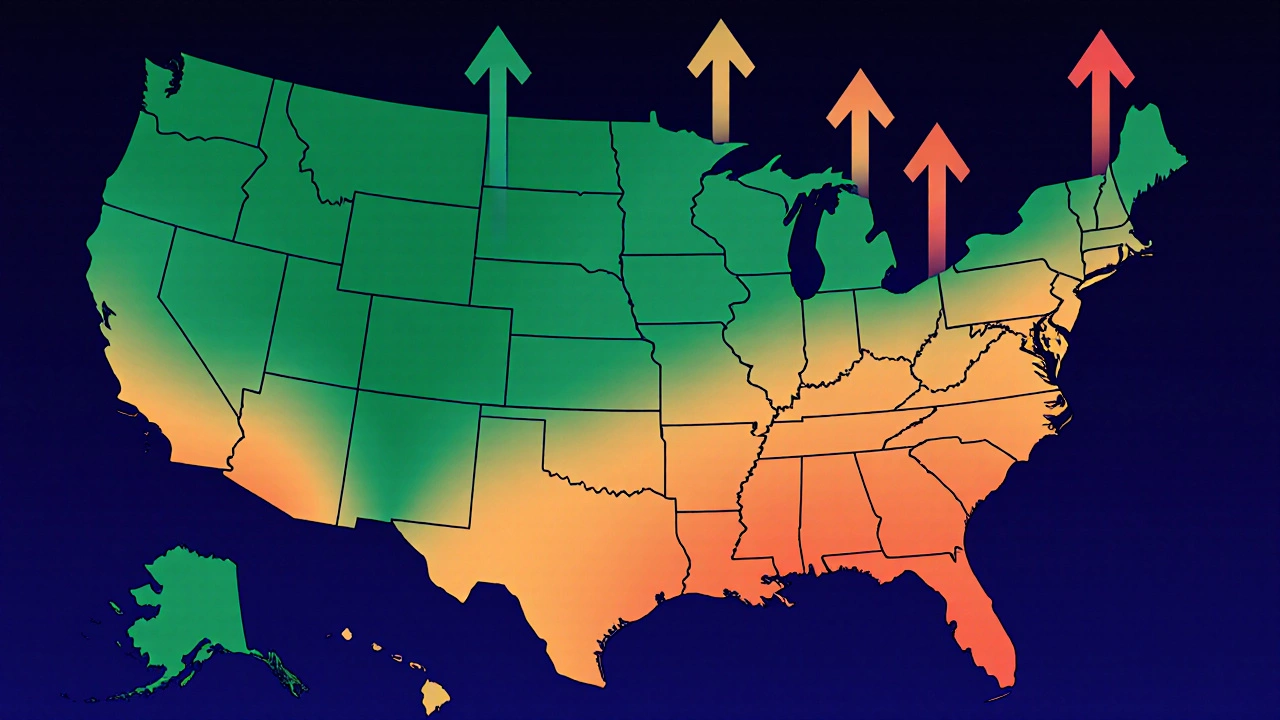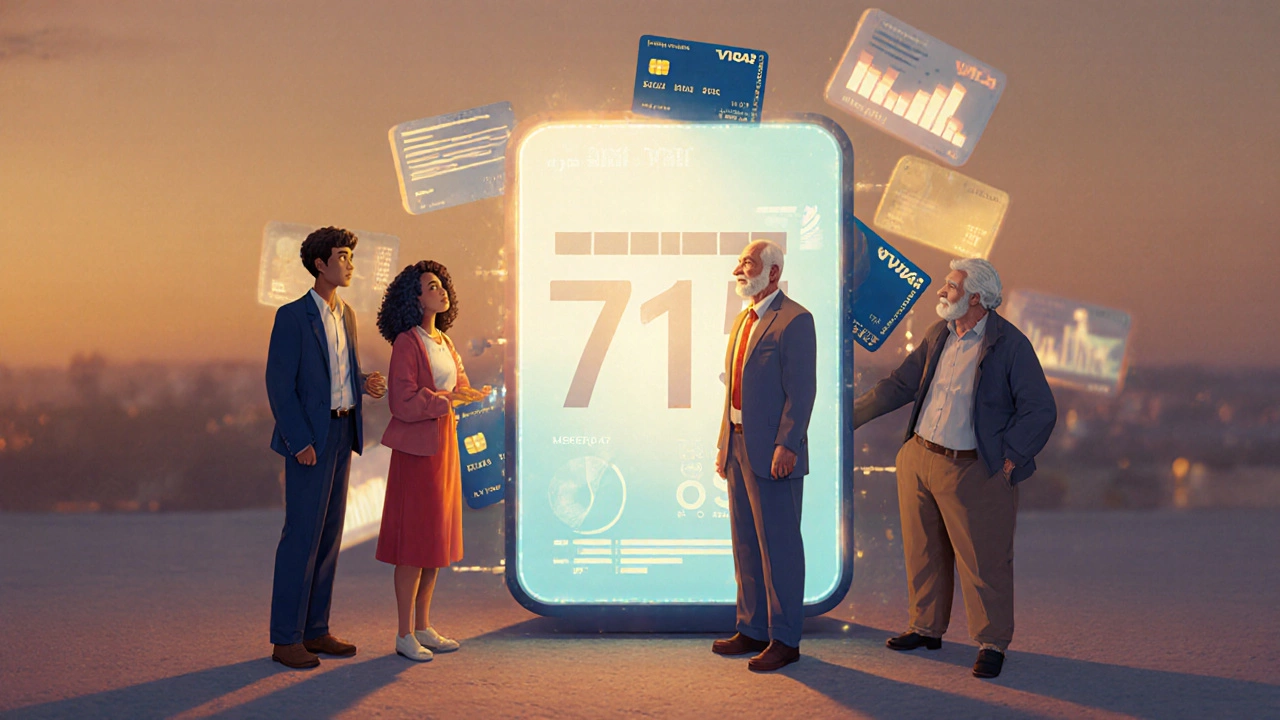Credit Score Savings Calculator
Calculate Your Potential Savings
How Your Score Impacts Rates
The national average credit score in 2025 is 715. Higher scores mean lower interest rates:
*Rates based on 2025 industry data
Your Potential Savings
Current Estimated Rate
-
Estimated Monthly Payment
-
Target Rate (760+)
-
Potential Monthly Savings
-
A 50-point increase in your credit score could save you over $86,000 in interest on a 30-year $300,000 mortgage.
If you’ve ever applied for a credit card, loan, or even rented an apartment, you’ve probably heard the term credit score. But what’s the real number most Americans are working with? It’s not just a random number - it’s the key that unlocks interest rates, approval chances, and even job opportunities in some cases. As of 2025, the average credit score in the US is 715, according to data from FICO and Experian. That’s higher than it was five years ago, but it doesn’t tell the whole story.
Why the average credit score matters more than you think
A credit score isn’t just a number lenders check. It’s a snapshot of your financial behavior over time. A score of 715 puts you in the ‘Good’ range - meaning you’re likely to get approved for most credit cards and loans with decent rates. But if you’re trying to snag the best mortgage deals or low-interest auto loans, you’ll need to aim higher. Lenders don’t just look at averages - they look at where you stand compared to the top performers.The top 20% of Americans have scores above 800. These people aren’t necessarily rich. They’re just consistent: they pay bills on time, keep balances low, and avoid opening too many new accounts. Meanwhile, nearly 1 in 5 adults in the US still have scores below 600, which makes borrowing expensive or impossible without a co-signer.
How credit scores are calculated in the US
Your score isn’t pulled from thin air. It’s built from five main factors, each with a different weight:- Payment history (35%) - Did you pay on time? Missed payments hurt the most.
- Credit utilization (30%) - How much of your available credit are you using? Keeping it under 30% helps. Under 10% is ideal.
- Length of credit history (15%) - The older your accounts, the better. Closing old cards can drop your score.
- Credit mix (10%) - Having different types of credit (credit cards, loans, mortgages) helps, but you don’t need all of them.
- New credit (10%) - Too many applications in a short time signal risk.
Most scores in the US are based on the FICO model, though some lenders use VantageScore. Both run from 300 to 850. The difference? FICO is still the gold standard, especially for mortgages. If you’re shopping for a home, make sure you’re checking your FICO score - not just the free one your bank gives you.
What’s the average score by age group?
Age plays a big role. Credit scores tend to rise as people get older - not because they’re richer, but because they’ve had more time to build good habits.- 18-29 years old: Average score is 679
- 30-39 years old: Average score is 686
- 40-49 years old: Average score is 706
- 50-59 years old: Average score is 729
- 60+ years old: Average score is 745
Younger adults often start with lower scores because they’re new to credit. But many of them are catching up fast. Student loans and credit-builder cards are helping more millennials and Gen Zers establish credit earlier than previous generations.
What’s the average score by state?
Credit scores aren’t the same across the country. Where you live can affect your score - not because of your personal habits, but because of economic conditions, cost of living, and access to financial education.States with the highest average scores in 2025:
- Minnesota: 742
- Wisconsin: 738
- North Dakota: 736
- South Dakota: 734
- Massachusetts: 733
States with the lowest:
- Mississippi: 677
- Alabama: 681
- Arkansas: 682
- West Virginia: 684
- Georgia: 685
It’s not about income alone. Minnesota and Wisconsin have high scores not because everyone’s rich - but because residents tend to carry less debt relative to income and avoid frequent credit applications.
How your score affects what you can afford
A 50-point difference in your credit score can cost you thousands over time. Let’s say you’re buying a $300,000 home with a 30-year fixed mortgage.- With a score of 760+: You might get a rate of 5.8%
- With a score of 620: Your rate could be 7.5%
That’s a $240 difference in monthly payments. Over 30 years? That’s more than $86,000 extra in interest. Same goes for car loans. A person with a 750 score might pay 3.9% on a new car, while someone with a 640 pays 9.2%. Over five years, that’s nearly $4,000 more in interest.
Even credit cards aren’t safe. A card with a 0% intro APR might be off-limits if your score is below 700. And if you carry a balance, a higher score could mean saving hundreds in interest each year.

What’s holding people back?
Many people think they need to be perfect to have a good score. But perfection isn’t required - consistency is.Common mistakes:
- Maxing out credit cards - even if you pay them off monthly
- Opening too many new cards in a year
- Not checking credit reports for errors
- Closing old accounts thinking it helps
- Missing a payment by even a few days
One study by the Consumer Financial Protection Bureau found that 1 in 5 people had an error on their credit report that could lower their score. These aren’t always identity theft - sometimes it’s a medical bill sent to collections by accident, or a utility company reporting late payments incorrectly.
The fix? Get your free reports from AnnualCreditReport.com once a year. Check them carefully. Dispute anything that doesn’t belong to you. It can take weeks, but a single correction can jump your score by 50 points or more.
How to improve your score - fast
You don’t need to wait years to see results. Here’s what actually works:- Pay every bill on time - set up autopay if you need to.
- Lower your credit utilization - pay down balances or ask for a credit limit increase (without spending more).
- Don’t open new credit unless you need it - each application drops your score slightly.
- Keep old accounts open - even if you don’t use them.
- Use a credit-builder card or loan if you’re starting from scratch.
Some people see a 50-point boost in as little as 60 days by focusing on just two things: paying down balances and fixing reporting errors.
What’s next for credit scores in the US?
The credit system is slowly changing. FICO 10 and VantageScore 4.0 now consider rent and utility payments - if they’re reported. More landlords and utility companies are starting to report on-time payments, which helps people with thin credit files.Also, some lenders are testing alternative data: bank account history, savings patterns, even how often you pay bills early. This could help millions of people who’ve been left out of the traditional system.
But the core hasn’t changed. If you pay on time, keep debt low, and avoid unnecessary credit applications, your score will climb - no magic tricks needed.
What is considered a good credit score in 2025?
A good credit score in 2025 is 670 to 739. Scores from 740 to 799 are very good, and 800 and above are exceptional. Most lenders consider 700+ as strong enough for the best rates on credit cards and loans.
Is 715 a good credit score?
Yes, 715 is a good credit score. It’s above the national average and puts you in a strong position to qualify for low-interest loans, credit cards with rewards, and favorable terms on mortgages. You won’t get the absolute best rates (those usually require 760+), but you’ll be far ahead of most borrowers.
How often does the average credit score change?
Your personal credit score updates monthly, as lenders report your activity to credit bureaus. The national average shifts slowly - usually by 1 to 3 points per year. In 2025, the average rose slightly from 713 in 2024 due to lower inflation, more stable employment, and better financial habits post-pandemic.
Can I check my credit score for free?
Yes. By law, you’re entitled to one free credit report from each of the three major bureaus (Equifax, Experian, TransUnion) every 12 months at AnnualCreditReport.com. Many banks and credit card issuers also offer free FICO or VantageScore access to customers. Just make sure you’re not signing up for a paid trial.
Does checking my credit score hurt it?
No, checking your own score is a soft inquiry and doesn’t affect your credit. Only when a lender checks your score during an application (a hard inquiry) does it have a small, temporary impact. You can check your score as often as you want without penalty.






